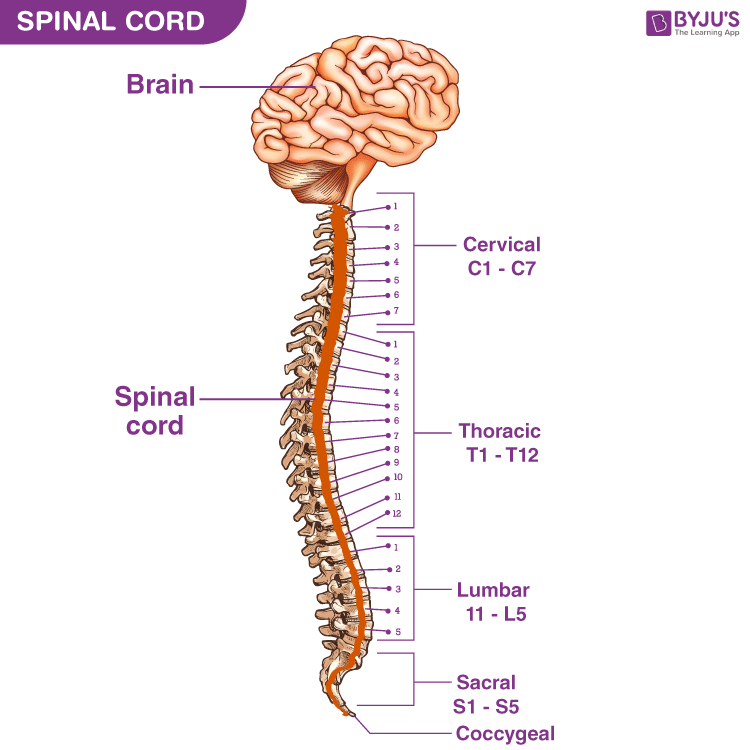Since joining Metrohealth’s SCI research team four months ago, a simple but common theme has emerged when using injury terminology with participants and their families: it’s complicated. Many researchers and clinicians choose to introduce standardized medical terms to participants in hopes of helping with understanding but forget how hard it can be to deduce meaning from such technical language without a background in the field. Therefore, the goal of this article is to create a quick, simplified guide to injury classification to help those with spinal cord injuries, their families, friends, and advocates make practical use of the medical jargon related to SCIs.
1. Neurological Level of Injury (NLI)
One of the principal methods for classifying an SCI is the neurological level of injury (NLI). To understand what NLI entails, its best to first know the basics of spine anatomy and physiology.
The human spine is divided into five distinct sections, each composed of a different number of vertebrae (the back bones). When someone hunches over and their back bones poke out, the ball-like projections we see are the spinous processes of each bone. Vertebrae are named based on the portion of the spine where they are found, and their number in order from top to bottom (when upright).

The alignment of the spine forms a central canal where the spinal cord lies. The spinal cord functions as an intermediate between the brain and body parts during the signal relay that allows for our coordinated sensation and movement. The nerves associated with each portion of the spinal cord have distinct functions (as shown in diagram #1), but they can also work in collaboration.
Due to their proximity to the spinal cord, when vertebrae are affected by an injury, so are the portions of the spinal cord they surround. As a result, signals can no longer travel through or past this region of the spinal cord.
Therefore, the NLI refers to the lowest portion of the spinal cord with intact (in very simplified terms, normal) motor and sensory functions following an injury. Knowing the NLI explains why certain sensation and movement may be absent/altered following an SCI.
2. Paraplegia vs. Tetraplegia
NLIs can be used to group injuries into two distinct categories: paraplegia and tetraplegia (the latter is also referred to as quadriplegia). The ‘plegia’ suffix refers to the resulting paralysis, while the assigned prefix describes its extent.
The ‘para’ prefix represents two, so paraplegia is paralysis of the two lower limbs. Paraplegia is typically thought of as paralysis from the waist down, but as shown in diagram #2, can entail altered function in the trunk as well. It is defined by an NLI at or below the T1 level. The T1 vertebra is found in the mid back, with diagram #1 showing its more precise location and associated nerve function.
The ‘tetra’ and ‘quad’ prefixes represent the number four, and therefore tetraplegia/quadriplegia is paralysis of all four limbs. These injuries are classified based on NLIs in the cervical (neck) region, shown on diagram #1 at the C1-C8 vertebrae.
3. Complete vs. Incomplete
The complete vs. incomplete convention is where injuries become a bit more variable.
Complete injuries occur when there is a total loss of sensation and movement below the NLI, as nerve communication has been fully diminished. This can occur at any NLI, as shown in diagram #2, so it is possible for someone with tetraplegia and paraplegia to both have complete injuries, despite having very different injury locations.
Incomplete injuries occur when there is any degree of preservation below the NLI, whether that be in the form of sensation, muscle control, or both. Incomplete injuries follow many different patterns and levels of preservation, unique to the individual based on personal health factors, mechanism of injury, recovery timeline, etc. Two individuals with incomplete injuries at the same NLI may still have very different functional abilities.
Classification Flowchart
These three conventions are typically applied in combination to quickly describe an individual’s SCI. Though this brevity is meant to be helpful, it is important to remember that individuals with the same injury type(s) can still have quite different experiences. Our hope is that by making these SCI classification terms more widely understood, individuals can gain tools for sharing their stories with others and coping with their injury.
